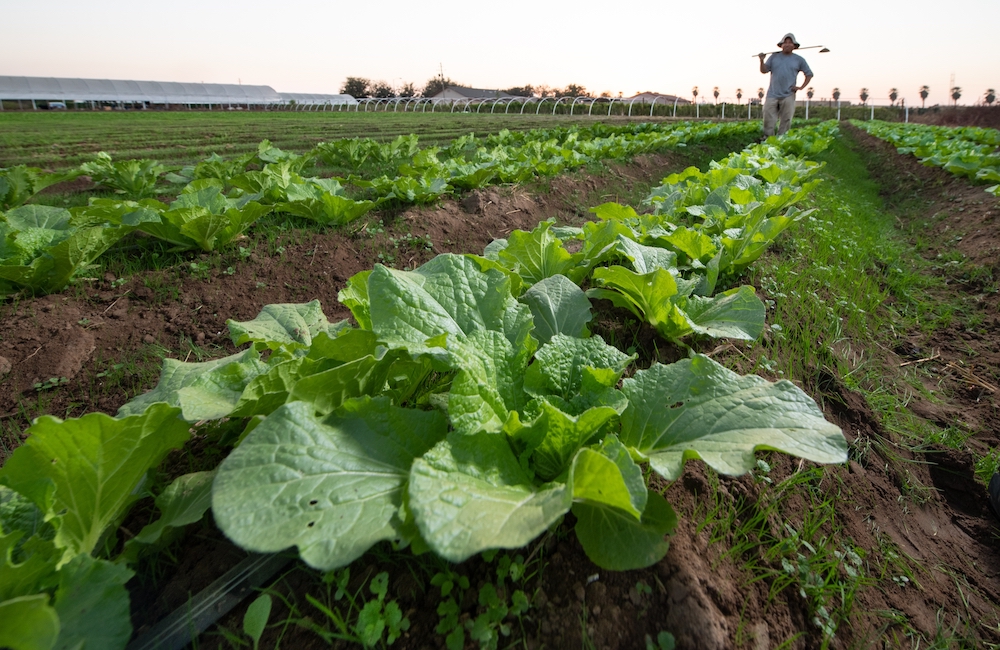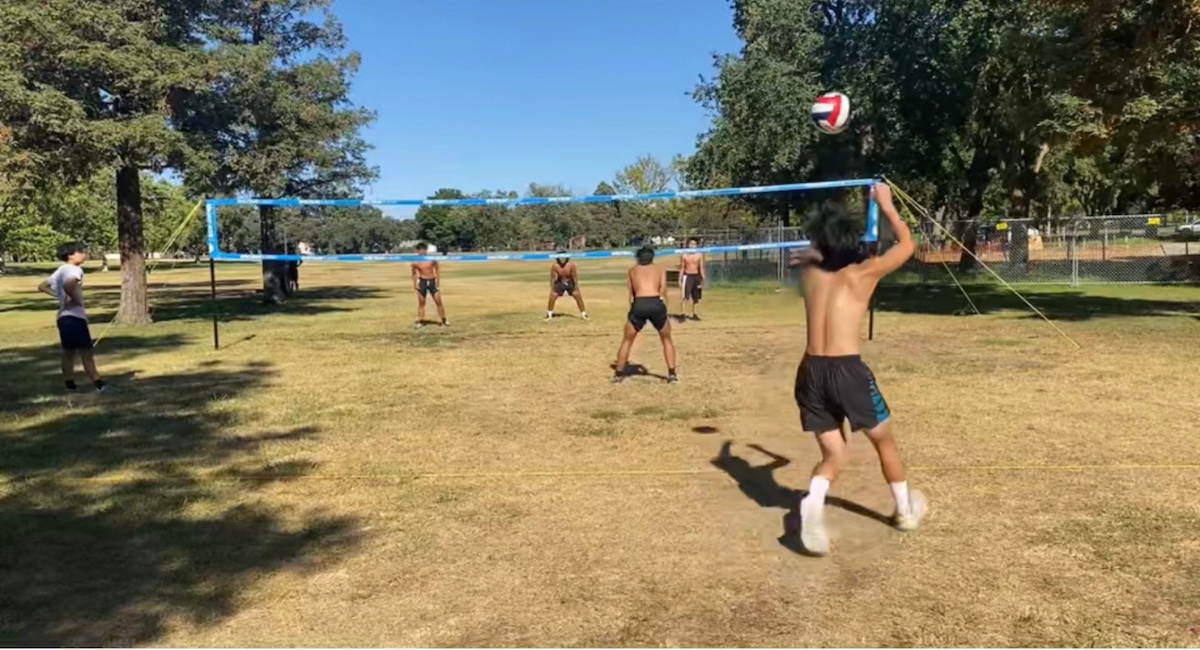By Macy Yang | Hmong Daily News
Above: Tou Lee and friends playing volleyball following a day of extreme heat. (Photo courtesy Tou Lee)
Extreme heat is among the deadliest of natural disasters. As heat waves blanket the state, certain segments of the population are at greater risk, including low-income communities, children, the elderly, outdoor workers, and those with medical conditions.
According to one recent study, emergency room and hospital visits for heat-related illness can top $1 billion each summer.
Here are some tips offered by members of the Hmong community on keeping cool and safe during periods of extreme heat.
Work-around Extreme Heat!
The Central Valley is known for its agriculture and triple-digit summer heat. The hot season lasts between three to four months and can often have a detrimental impact on many of the state’s vulnerable populations.
Farmers are especially vulnerable to weather conditions like heat which present significant challenges not only to the farmers but their crops. Extreme heat conditions can impact yield and productivity; and, for small family farms, that can mean a dent in their income.
More than 35,000 Hmong call Fresno home. Fresno is the second-largest Hmong community in the US.
Teng Thao and his family own 20 acres of farmland in southeast Fresno—where they have farmed for 30 years. Growing seasonal crops like bitter melon, Asian squash, and other varieties of Asian specialty crops, Thao sells his crops at local farmers’ markets throughout the year.
“Farming is very different for everyone,” Thao said. “For us, we live on the farm, and it makes it easier. The heat does not impact us as much because our house is right there.”
Thao said, unlike other farmers, his water well has not given him any problems during the past few years of drought. Even in hot weather, his crops get plenty of water.
Thao’s day starts around 7:00 am, and he works until noon then breaks just as it starts to get hot. When the sun cools down in the evening—that’s when he returns to work again.
He said he also has small makeshift sheds on the land that are used for shade.
When working outside, it is important to wear a hat for protection, long-sleeved, loose-fitting clothes, and drink plenty of water throughout the day.
According to the USDA, Fresno County has more than 800 Asian-owned farms.
Tip: Work-around extreme heat by working early and at cooler times of the day. Stop working during peak times to rest and cool down. Dress for the job and drink plenty of water even when not thirsty.

Summertime is a Fun Time
As a kid, summer vacation meant playing outside, riding bikes, and swimming. This year’s summer vacation has a different meaning for Tou Lee, a student, in Sacramento.
“All those summer activities that we used to do; we just can’t do anymore because it’s too hot,” Lee said. “If we want to do something outside, we’d have to wait until it cools down usually late in the day.”
Lee has had to adjust his summer activities to more indoor activities. For one, he took up weightlifting instead of playing sports outside.
“When we want to go out, we plan for it,” he said. Lee and his friends recently took a late-night trip to the popular Sacramento State Fair at Cal Expo. “It was over 100 degrees during the day, instead we went later when it cooled down,” he said.
“As kids, it’s hard to stay indoors. We can still do the things we want to do, but we learned to plan and go out when it’s cooler,” he adds.
Pay special attention to infants and children, they do not cool down like adults. Apply sunscreen on children and a wet cloth to their forehead or the back of their neck to help them cool down.
Tip: Stay indoors as much as possible. Alter your outdoor activities to indoor activities whenever possible or plan your outdoor activities for a cooler time in the day.
Cooling Centers
“I work at the Southgate Library in Sacramento,” said Dylan Yang. “I’ve noticed a lot of people coming into the library during the hottest time of the day, which is 11:00 to 3:00 pm.”
Families come into the library to read books and use the computer. The library also offers free lunches for kids, so the kids get their lunch too, which is another reason for families to come and cool down.
The library is open from Tuesday to Friday. On any given day, Yang said, he estimates that 40 to 60 families walk through the library.
Extreme heat cooling centers can be located on the Cal OES website by county. The Governor recently launched HeatReadyCA.com – one of the nation’s first multi-ethnic awareness and education campaigns aimed to keep Californians safe during extreme heat.
Tip: Look for cooling centers like the library, the mall, or other public places to cool down during hot times of the day.
Natural Shade
Heat impacts even the smallest Hmong communities nestled in pockets of California’s most northern region.
“Even though the elevation is higher at 3,600 feet, we still feel the same heat,” said Kao Xiong. “It tends to be cooler in the morning, the temperature runs about 50 to 60 degrees, but about mid-day, we reach 100 or more. The nice thing about living in the mountains is that the temperature drops at nighttime to about 40 to 60 degrees when it gets cool again,” Xiong adds.
During the hottest time of the day, people tend to stay indoors to stay cool, take naps, or do their cooking and other chores. Xiong said he will also cook during daylight and eat later when the food and temperature are cooler.
There are plenty of trees and pine that provide a substantial amount of natural shade and cooling in more mountainous regions.
When living off the grid it means no AC. Plywood sheds often used for housing, with no insulation, are still cool inside even in hot weather because of the surrounding natural shade. Opening the windows in homes early in the day is enough to cool down the entire house.
It is estimated that as of 2017, approximately 1000 Hmong moved to Trinity County. The Hmong population in Siskiyou County makes up 2.6% of the population in that county.
Extreme heat is expected to increase in the coming years due global warming.
Tip: If you are living in a home without AC, opening the windows early and late at night will help cool down the home. Watch what you eat! Eating hot foods will cause your temperature to increase.
Stay informed. Check the National Weather Service Heat Risk.
This story was produced as part of a collaboration with the Office of Community Partnerships and Strategic Communication for their Heat Ready CA public awareness and outreach campaign. Visit Heat Ready CA to learn more.




